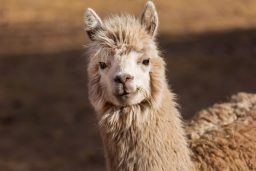If raised correctly with good husbandry – neither is aggressive. However, the llama tends to be more independent-minded and so can seem bolder as an adult, then the alpacas.
Are Llamas Or Alpacas More Aggressive?

Both llamas and alpacas are members of the camel family – and two of the 4 native camelid species of South America.
The wild Guanaco and Vicuna are the original species that the llama and alpaca were domesticated from.
As we know – the domesticated version of anything is naturally less aggressive to humans as that is how they have been bred over the centuries. They need to be partially or fully people friendly to be of any use in domesticating in the first place.
Both llamas (from guanacos) and alpacas (from vicunas) have been domesticated since prehistory. We know this as there are depictions of them being used within the Moche Culture ( 100-600CE) and so the animals we see today have had centuries of selective pressure applied to them for handleability, calm nature, and a willingness to be handled and farmed – just like with other livestock.
There are, of course, always individuals who are raised or bred incorrectly and so have what we humans call “a character” which means they are labeled as “a bit naughty”.
Also, read our article on “Do Llamas and Alpacas Spit”
Behaviors Of A Llama:
Llamas are more independent-minded in general than alpacas. They are herd animals and work with the herd – but rather than depend on the herd at all times, they are very much for themselves when kept alone or in smaller groups.
Although they aren’t aggressive to humans, as a rule, they can become that way if incorrect husbandry techniques are used. And seeing as they are quite a large animal (topping 1.7m (5ft 7in) between the ears – and weighing up to 200kg (440lbs)) they know they can get away with it.
A young llama (a cria) taken from its mum too young and hand-reared like a doll will think that you (the human) are a llama too – and so will act like you are a llama.
This entails spitting at you, kicking you, and hitting you with their giant neck when they want to show you who is boss. Not good.
However on the other hand – a correctly socialized cria will make a great animal or pet – and llamas have even become therapy animals due to their calm nature (and soothing effects or that soft fur and their big ole eyes!).
They are also sometimes used as guard llamas. A single, neutered male llama will protect his herd of sheep or other smaller livestock from anything.
You could say they were aggressive here as they will fight off predators (like coyotes and jackals) if they feel threatened. They can even take guard of a flock of their smaller relatives, the alpacas.
Behaviors Of An Alpaca:
Alpacas on the other hand are much more herd-oriented – and take humans in as part of the herd.
They are much more tolerant overall as a species than the larger llamas and also look more adorable with their softer and more fluffy hair. However, they don’t really like to be petted if they can avoid it – so no therapy animals here.
Additionally, alpacas are bred for their wool alone rather than as pack animals like the llama and so they don’t come up against changes in human demands or locations.
They stay all day in their lovely field getting fed the best foods and protected from the elements (to make sure their wools is the very best) – while llamas can be saddled up, loaded with goods (or picnics in the U.S.), and dragged 50 miles up in the mountains by some loud tourists.
No wonder the llamas are more often called grumpy?
Just like with llamas though, an over-coddled cria can turn into a pest as it ages. Additionally, the males can be aggressive with each other if they are kept together as this is just their natural hormones getting in the way of things.
For them it is totally normal – it is just us as owners who dislike this behavior.
Because farmers in the UK have smaller predators (foxes and pet dogs only) the alpacas take the place of the llama over there as guard animals. Alpacas will actively charge animals they deem as a threat and can protect sheep from attack while they are lambing.
So, both are as adorable as the other really.








